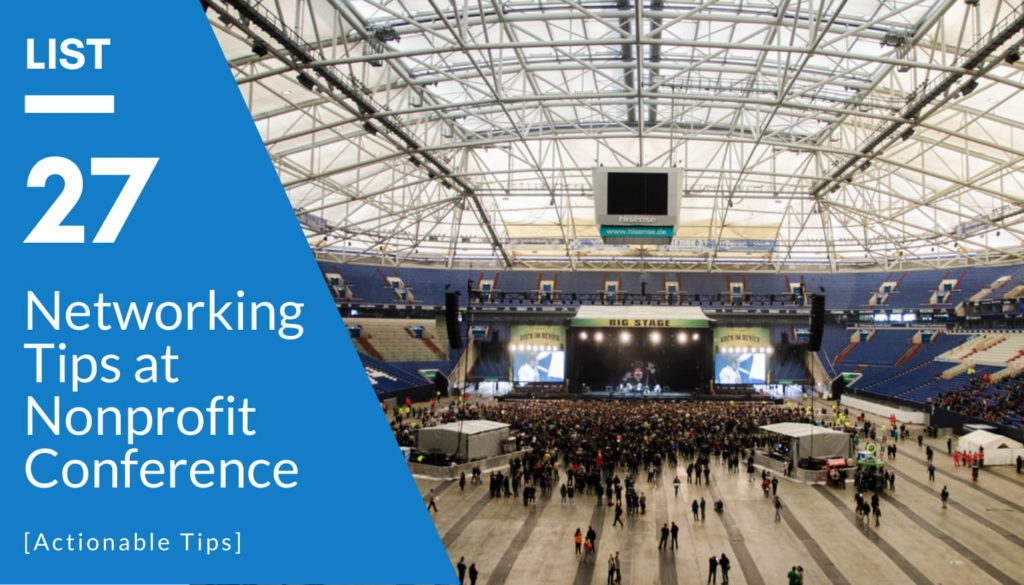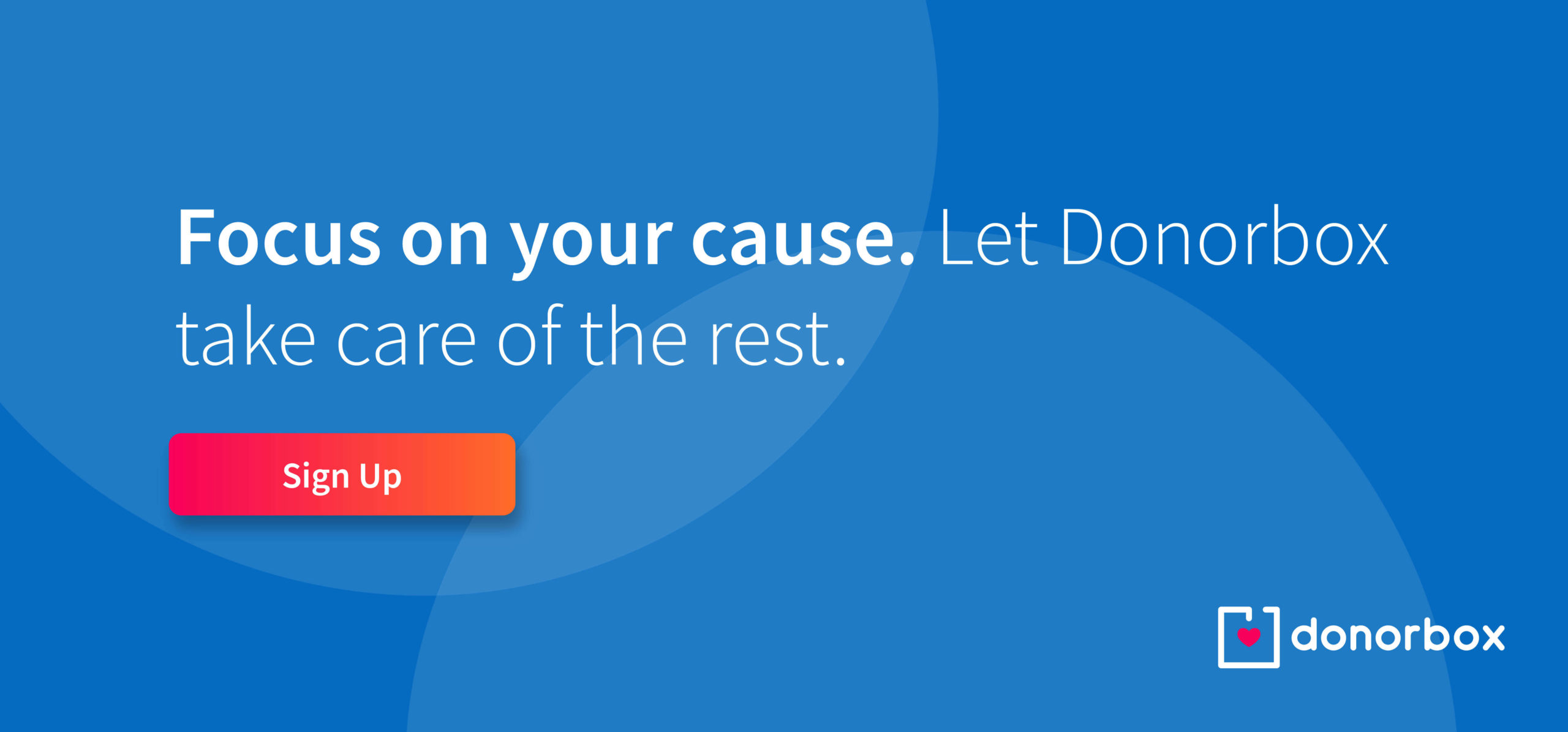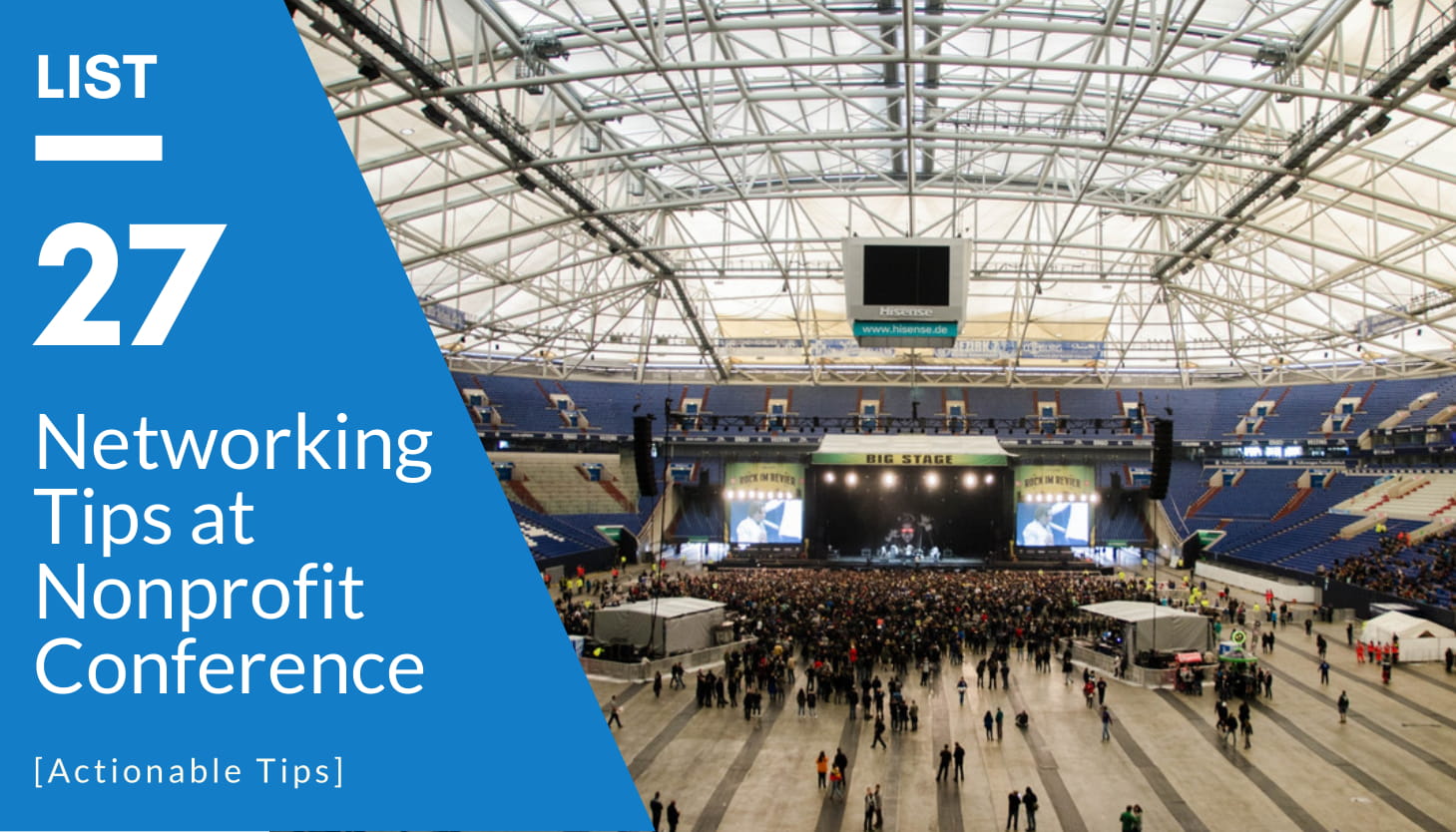
Networking can seem like a daunting endeavor, even to the most experienced nonprofit professionals. There’s a lot to navigate when thinking of it all: “How do I mingle with speakers? What’s the right etiquette when walking into a session or having meals? What should I wear? What, exactly, should I do during break time?”
While networking can indeed be nerve-wracking, nothing can replace the power of face-to-face interactions. And networking with prospective donors, media, prospective partners and employees is key to succeeding in the nonprofit space.
In this guide, we highlight the potential hurdles you could endure while networking at conferences, complete with tips and practical advice on how to overcome them, and how to make the most of your time there.

What is Networking?
Let’s start by looking at what networking is not.
Networking is not about collecting the most business cards or LinkedIn connects.
It’s also not about meaningless empty chatter.
And it also isn’t just something you do during an event.
It’s a relationship-building process and one that you should take part in before, during, and after the event itself.
Before the Conference
1. Find the right conference
The best possible conference is the one where you know you’ll be able to give something to every person you speak with. If you’re simply going out there to throw out business cards, that’s not smart networking.
Instead, look for events in your niche market or a complementary one. This is where it pays to deeply understand your target market and ideal donor and partner. If you don’t know who they are, or think you’re reaching out to “everyone,” you’re not going to have much success networking.
2. Study the attendee and speaker lists
If available, study the attendee and speaker lists to check out who will be there and decide which individuals you’d like to connect with. Try to arrive prepared and network with intention.
You can look at the conference attendees list or maybe even a Facebook event to see who will be there and who might be interesting for you to connect with rather than networking with everyone. This will help you focus your efforts during the conference.
3. Meet and interact with people before the conference actually starts
If there is a speaker you’d like to meet, follow them on social media and start engaging them a few weeks or more before the conference starts.
It can help facilitate a connection if the speaker or the attendee recognizes you from seeing your name and face beforehand.
Pro tip: It’s great to try and make a few connections ahead of time, but don’t overdo it or stress over it. You won’t be able to meet with everyone and you’ll cheapen the experience if you start making connections to “make connections” instead of because you’re genuinely interested in people.
4. Schedule meetings ahead of time
For many, the most difficult part of networking is finding the courage and energy to introduce themselves to a complete stranger. Walking up to someone who isn’t expecting you can be nerve-wracking.
If this is a major obstacle for you, avoid it as much as possible by setting up meetings in advance. Identify a few people you are interested in meeting, and a month or so before the conference, send an email introducing yourself and asking if they have time to chat during one of the breaks. Scheduling meetings means that you’re more likely to get one-on-one time.
5. Examine the venue layout
Most conferences will provide you with a map of the conference venue to give you an idea.
Use this to your advantage by planning your route ahead of time to ensure you get the most out of your time at the conference.
6. Practice your ‘elevator pitch’
An elevator pitch is a 30-second to a 1-minute description of yourself, your mission, and your organization.
Keep your pitch short, focused, and powerful. Get your key bullet points down and run them by your partners, friends, and acquaintances.
Be clear on what problem you are tackling and how. The problem and the solution should be very clear.
Don’t spew out your elevator pitch without paying attention to the context you’re in. The best elevator pitches are contextual. Diving right into your programs and all the amazing things your nonprofit has accomplished so far (or, God forbid, donation tiers) at this point isn’t going to get you anything but an annoyed expression from the person you’re talking to.
However, while you should never just blurt out your overly rehearsed elevator pitch, having one helps when you’re put on the spot or you’re very nervous.

During the Conference
7. Every moment counts
Every moment counts, so be extremely kind to everyone from the moment when you walk into the venue. From the check-in table area to the cloaks room, treat everyone as an equal.
Kindness and empathy are not only respectable traits but can also open many doors in unexpected ways.
8. Get out of your shell
To get the most out of nonprofit conferences, get out of your shell and out of your comfort zone.
Don’t just sit down and have lunch by yourself, join a table, and introduce yourself. When you see someone standing alone, go up to them, and introduce yourself. Attend informal lunches and dinners that are organized outside of the conference agenda.
When you sit down at a talk, introduce yourself to people who are around you. Show up early for talks. Introduce people you met with each other if you think they have something in common.
Pro tip: Find a conference friend to split the sessions with and agree to compare notes at the end of the day. This is a great way to ‘cover more grounds’ and build a deeper relationship with someone.
9. Be genuinely interested
When the speaker talks, pay attention and nod to show that you are understanding and following what the speaker is saying. This can build a lot of rapport with the speaker and help you start a meaningful conversation afterward.
Be genuinely interested in the people you meet. Don’t worry about what they do or what they can do for you. Instead, focus on the actual conversation at hand and show a genuine interest in what they are talking about.
Pro tip: Don’t just go after the really well-known speakers. If someone spoke eloquently and you found their session interesting and informative, but they are lesser known – approach them. These people generally have more time to talk to you and can be fountains of knowledge.
10. Use the event app
Many conferences nowadays use apps to deliver more personalized and immersive experiences to their attendees. If the conference you’re attending uses one, don’t hesitate to use it.
Some conferences even use the R.F.I.D. technology (Radio Frequency Identification – unlike barcodes, which must be scanned, RFID chips can be read in rough proximity to a scanner) to provide alerts for attendees when they were close to people they wanted to meet.
11. Go up the speakers after their talk
Congratulate the speaker on the talk they just did and compliment them on something about the talk, and then briefly introduce yourself, perhaps ask a small question and see if you can catch up with them later.
However, be mindful. The speaker might want a break, might want to use the restroom, or maybe simply wants to decompress and take a minute after their talk.

12. Prepare for the chance encounters
If you’ve done your homework and identified people you’d like to connect with, do some extra work and memorize their faces if possible, alongside an interesting fact. This way, if you meet them in a queue or at a meal, you can say “You’re Anna Jones, right? I’ve been following the work of your nonprofit for a while now. By the way, I heard you love skiing. What’s the coolest spot for winter sports you’ve been to recently?”
With a conversation starter like this one, Anna is more likely to recall you and the contact is more likely to stay alive later on.
13. Have your business cards ready
Business cards are one of the quickest, most effective ways to introduce yourself and share your contact information. If you prefer to connect on social, add your Twitter handle and other social details on your card.
If you don’t have business cards, create some. More importantly, your card needs to stand out, and it has to say something about you.
Yes, you ideally want to give out as many of your business cards as you can. At the same time, you do not want to push them onto others.
Pro tip: Take notes on yours or your contact’s business card about your conversation to refer to later. That conversation might be fresh at that moment, but after having many more you might forget meaningful and important information that might help you later on.
14. Think about how you can help
Instead of constantly focusing on what you can get from the person you’re talking to, think about what you can do to help them.
When you approach your contacts, check-in with them first and sense where they’re at. Before ‘getting down to business’, take the time to learn something about this person – perhaps inquire about their interests, passions, or challenges.
Here are a couple of questions you could start with:
- How did you hear about this event?
- What’s your story?
- How and why did you first get started in the nonprofit world? What kept you going?
- What else would you recommend I read/watch about this topic?
Help others solve problems or answer their questions, even if it doesn’t lead to a donation.
Give away the resources you have, like books, recommendations, free tickets to your events, and more.
15. Be approachable
During the conference, stay and look as approachable as possible. Don’t spend all your time outside of conference sessions using your electronics.
By looking open and inviting, you’ll make it more likely that someone else, looking for someone to talk to, will approach you.
16. Pay attention to details
Research shows that within the first seven seconds of meeting others form a solid impression of who you are – and some research suggests a tenth of a second is all it takes to start determining traits like trustworthiness.
Be enthusiastic and knowledgeable, but not over the top. Be persistent, but not aggressive.
Take note of your body language. Speaking slowly and deliberately is a sign of confidence, as is good posture. Make eye contact, react to what the person you’re speaking to is saying and ask follow-up questions, nodding along.
17. Don’t hesitate to take a break
It can be hard to justify breaks and alone time since nonprofit conferences are usually only a few days long and are often expensive to attend, but breaks will be critical to your success, especially if you’re an introvert and social interactions of this kind exhaust you.
Small breaks can increase your engagement during the rest of the time spent at the conference. Build alone time into your daily schedule.

After the Conference
18. Follow up with an email
Follow up with an email, remind them what you spoke about, offer them a link to an interesting article, connect on LinkedIn, or schedule a “no agenda” coffee meeting.
19. Connect on socials
If appropriate, connect to your contacts on LinkedIn and Twitter, and start engaging with their content.
20. Add your contact to your CRM
Use a CRM and keep track of your leads and prospects, monitor every touchpoint, from email to phone calls, and set reminders to follow up when you promised you would.
21. Consistently offer value
In the weeks following the conference, keep building relationships with your contacts, consistently offering value, help, and resources. Invite your contacts to your events, think of projects you could work on together, and share ideas.
22. Talk about it
Whether you’re on Twitter, Facebook, or Instagram or you just have a blog, show your love for the conference you attended online.
Apply conference lessons after using social media. For example, if you heard a speaker at a conference give a great talk on inclusion and then you read an article a couple of weeks later about inclusion in the nonprofit world, share that article, tag the speaker or conference organizer, and use the conference hashtag.
Bonus Tips
23. Get the dress code right
While ideas definitely matter more than clothes, fitting in with the dress code can help you feel more comfortable and focused on what matters. If the conference you’re going to is an established big one, check out the website and find pictures to see what people are wearing. If you’re not able to figure it out for yourself or you haven’t received an email about it, feel free to email the organizers and ask.
24. Stay hydrated
During a conference, you’re likely to constantly be ‘on the go’. Make sure you stay hydrated and go easy on the alcohol.
25. Respect boundaries
Stay aware of other people’s personal space and make sure you don’t follow anyone around in a way that would make them feel uncomfortable.
26. Meet the conference organizers
In their chase after the speakers, many miss out on the opportunity to meet the conference organizers. The conference organizers possess valuable information that might come in handy.
27. Head to Starbucks
Well, not necessarily Starbucks. Head anywhere where you might meet others outside of the conference context. Such places might include the gym, the hotel bar, local cafes, and more.

Conclusion
Nonprofit conferences are great places to learn more about the upcoming technologies and strategies for marketing to your nonprofit’s supporters and asking for donations.
They can also help enhance your knowledge of the various aspects of nonprofit management, including fundraising, marketing, technology, and strategy. Finally, nonprofit conferences can provide information from experts and facilitate information-sharing between nonprofit professionals.
By attending them, you gain valuable insights that you can then take back home to your organization. These insights, if taken on board and implemented, can help your nonprofit accomplish its goals.
At Donorbox, we strive to make your nonprofit experience as productive as possible, whether through our online donation system or through resources on our nonprofit blog.










